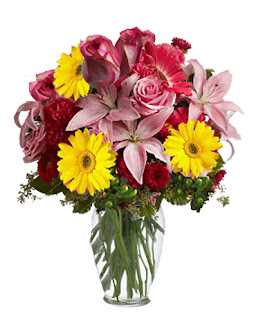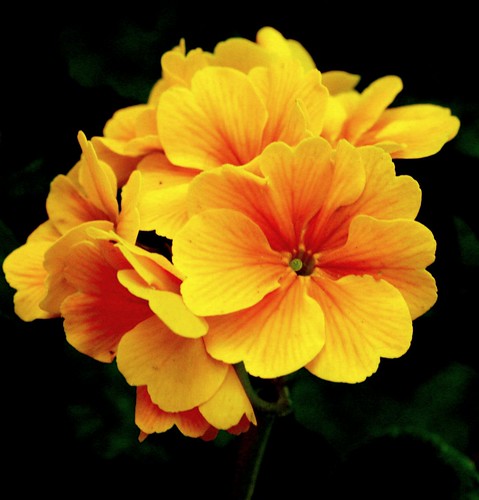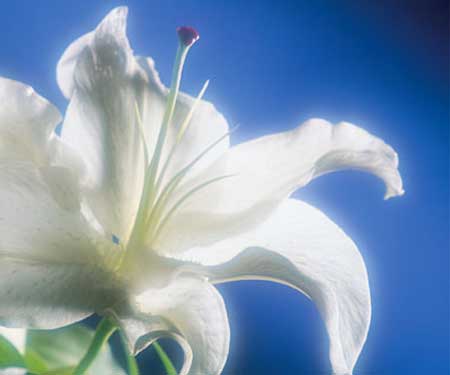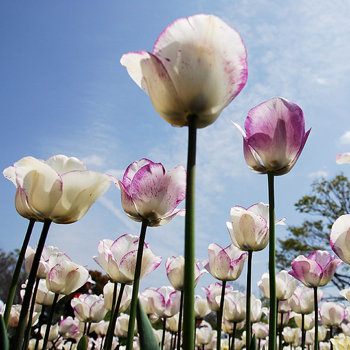Autumn, with its ocher colors and fallen leaves, with their gray days that are becoming increasingly shorter, is an ideal time to fill your home with bright and colorful flowers.
Here we reveal to you which species are best suited for these months and how to care them.
Yes, flowers raise people's morale and give positive energy to any environment. This fall, fill your home with flowers and enjoy with your family this gift of nature.
Recommended flowers for fall:
Violet: Grows well with an average temperature of 18 º C. Because it is a indoor or terrace flower, prefers indirect light. Water it every day but avoid that the leaves come into contact with water.
Dahlia: Resists perfectly to fall since it is not too cold, as it does not tolerate frost. It is an outdoor plant that needs to receive direct sun to bloom. Try to water it every day.
Chrysanthemum: Need light and water to flourish. If you put the flower inside, try to place it near a window where it will receive direct sunlight.
Sunflower: Since receiving a good deal of light and water, will fill your garden or terrace of golden tones. You just have to avoid exposing them to high and direct winds
Flowers photoblog
Saturday, September 22, 2012
Wednesday, September 12, 2012
Dutch tulips, the first speculative bubble
Late 1630s the Dutch economy went crazy, the market traded at astronomical prices tulips amounting without ever reaching the limit. People began to behave irrationally. Luxury homes were sold in exchange for a single bulb, and flowers were sold in exchange for the salary of fifteen.
A single bulb could be worth 1,000 florins (the average person in the Netherlands had an annual income of 150 florins). In 1635 they came to pay 100,000 guilders for 40 tulip bulbs. He even came to pay 5500 florins for a single bulb of Semper Augustus precious species.
This situation began to create a bubble in which prices rose and rose and never fell. The Dutch population is generated the illusion that the tulip market would always be a bull market. Such was the euphoria that was created a futures market where trading bulbs not collected yet, this business was called "windhandel" which translated means "air business!" All social status began investing in tulips and disposing of their most basic, and even went into debt to acquire mortgaged tulips. There came a time when it is no longer exchanged bulbs but formed a real financial speculation through credit notes.
Well into 1637, speculators began to detect signs of exhaustion in the tulips market. On February 5, a batch of 99 great rarity tulips was sold for 90,000 florins. Investors decided to start selling and collecting profits. This attitude was quickly infected the rest of the market, generating a significant amount of supply of tulips that led to widespread panic in the country. In mid-February, the holders of bulbs bought at astronomical prices they met overnight with no buyer, was even worse for the most daring speculators who had signed futures contracts obliging them to buy the bulb at a much more higher than the market.
The bubble burst left much of ruined investors, as they had liquidated its assets to speculate tulips that ended without any value. He saved all the bubbles as more rational investors left the market just before it exploded, triggering panic in this way in the country. Since then Holland for years engulfed in a major economic recession caused by the tulip bubble.
A single bulb could be worth 1,000 florins (the average person in the Netherlands had an annual income of 150 florins). In 1635 they came to pay 100,000 guilders for 40 tulip bulbs. He even came to pay 5500 florins for a single bulb of Semper Augustus precious species.
This situation began to create a bubble in which prices rose and rose and never fell. The Dutch population is generated the illusion that the tulip market would always be a bull market. Such was the euphoria that was created a futures market where trading bulbs not collected yet, this business was called "windhandel" which translated means "air business!" All social status began investing in tulips and disposing of their most basic, and even went into debt to acquire mortgaged tulips. There came a time when it is no longer exchanged bulbs but formed a real financial speculation through credit notes.
Well into 1637, speculators began to detect signs of exhaustion in the tulips market. On February 5, a batch of 99 great rarity tulips was sold for 90,000 florins. Investors decided to start selling and collecting profits. This attitude was quickly infected the rest of the market, generating a significant amount of supply of tulips that led to widespread panic in the country. In mid-February, the holders of bulbs bought at astronomical prices they met overnight with no buyer, was even worse for the most daring speculators who had signed futures contracts obliging them to buy the bulb at a much more higher than the market.
The bubble burst left much of ruined investors, as they had liquidated its assets to speculate tulips that ended without any value. He saved all the bubbles as more rational investors left the market just before it exploded, triggering panic in this way in the country. Since then Holland for years engulfed in a major economic recession caused by the tulip bubble.
Sunday, September 9, 2012
Cut Flowers Care
The purpose is to preserve cut flowers for the longest possible time.
Flowers are fragile and must provide them with great care.
Just follow these basic precautions and keep your flowers fresh and beautiful for much longer:
Many flowers boxes bring chemical preservatives. Follow the instructions.
The leaves of the stem should never be under water. Draw the lower leaves carefully.
Cut the stems an inch
Try to have the flowers in a cool place, away from heat and direct sunlight
Change the water every two days
Add 3 drops of bleach and some sugar to the water.
Flowers are fragile and must provide them with great care.
Just follow these basic precautions and keep your flowers fresh and beautiful for much longer:
Many flowers boxes bring chemical preservatives. Follow the instructions.
The leaves of the stem should never be under water. Draw the lower leaves carefully.
Cut the stems an inch
Try to have the flowers in a cool place, away from heat and direct sunlight
Change the water every two days
Add 3 drops of bleach and some sugar to the water.
Saturday, July 7, 2012
Flowers resist the crisis
While many sectors of the economy suffer with international crises, the segment of flowers and ornamental plants has weathered increased by 12% the volume of production.
According to experts this increase is due to large supermarkets and even convenience stores began offering plants, beyond the flower delivery services over the internet.
Thursday, October 13, 2011
Tuesday, August 23, 2011
Thursday, June 23, 2011
Sunday, May 1, 2011
Saturday, April 2, 2011
Monday, March 21, 2011
Wednesday, February 2, 2011
Flowers Care
Flowers Care
The purpose is to conserve as much as possible the flowers that has been acquired. The flowers are fragile and they must pay the utmost care. Just follow a series of basic care and keep your flowers beautiful and fresh for much longer.
In the box you'll find with the flowers you received, an envelope of nitrates. Put the content in the flowers water. Nitrates provide nutrients to the water to help preserve the flowers longer.
Cut the stems about an inch possible in oblique. The stem end dries out during transportation and does not absorb nutrients. By this simple operation will feed your flowers properly.
The stem leaves should never be in the water. Cut the lower leaves carefully.
Try to keep the flowers in a cool place away from sources of heat or cold as the sun, heating, air conditioners, electrical appliances.
Try to change the water in the container about every two days.
The purpose is to conserve as much as possible the flowers that has been acquired. The flowers are fragile and they must pay the utmost care. Just follow a series of basic care and keep your flowers beautiful and fresh for much longer.
In the box you'll find with the flowers you received, an envelope of nitrates. Put the content in the flowers water. Nitrates provide nutrients to the water to help preserve the flowers longer.
Cut the stems about an inch possible in oblique. The stem end dries out during transportation and does not absorb nutrients. By this simple operation will feed your flowers properly.
The stem leaves should never be in the water. Cut the lower leaves carefully.
Try to keep the flowers in a cool place away from sources of heat or cold as the sun, heating, air conditioners, electrical appliances.
Try to change the water in the container about every two days.
Wednesday, October 20, 2010
Flower Bulbs
Flower Bulbs
Some plants have the base of the stem, the bulb, an underground structure with gems, which are born of their shoots.
Protected by leaves that undergo changes in color and consistency, is that it stores mineral reserves, which are essential during the rest period before the first buds appear. And it is the kind of "potato" that determines the division between the bulbous, which can be played by corm, tuber, rhizome or bulb.
The corm is compact and has no layers. Inside are not seen leaves and flowers. The Gladiolus is a corm, like Freesia.
In tubers, the main feature is the presence of roots throughout the bulb (a bulb and a corm have real roots only at the base). Examples: the tuberous Begonia and Dahlia.
The rhizome is a thickened stem that grows horizontally underground, developing several gems.
Popular bulbs:
Amaryllis: In the bulb there is already a miniature flower. Plant this bulb in a pot and leave it in place with good lighting, and protect them from the sun at midday.
Gladiolus: spreads by corm, like Freesia. Ask sandy-clay soil without soaking, and likes full sun, do not water too much.
Narcissus: true bulb, increases in volume every year, until reaching its maximum size, are produced then other bulbs that bind to the largest. These divisions can be separated and saved for another plant. The ideal time to reap the daffodil bulbs is when their leaves fall off naturally. By separating the smaller bulbs bulb not do the operation in the sunlight, so they do not dry. It is suitable for cultivation in cold regions of the country.
Lily: In the spring, plant your bulbs in the garden. To reproduce by bulbils, tiny bulbs that appear in the leaf axils.
Some plants have the base of the stem, the bulb, an underground structure with gems, which are born of their shoots.
Protected by leaves that undergo changes in color and consistency, is that it stores mineral reserves, which are essential during the rest period before the first buds appear. And it is the kind of "potato" that determines the division between the bulbous, which can be played by corm, tuber, rhizome or bulb.
The corm is compact and has no layers. Inside are not seen leaves and flowers. The Gladiolus is a corm, like Freesia.
In tubers, the main feature is the presence of roots throughout the bulb (a bulb and a corm have real roots only at the base). Examples: the tuberous Begonia and Dahlia.
The rhizome is a thickened stem that grows horizontally underground, developing several gems.
Popular bulbs:
Amaryllis: In the bulb there is already a miniature flower. Plant this bulb in a pot and leave it in place with good lighting, and protect them from the sun at midday.
Gladiolus: spreads by corm, like Freesia. Ask sandy-clay soil without soaking, and likes full sun, do not water too much.
Narcissus: true bulb, increases in volume every year, until reaching its maximum size, are produced then other bulbs that bind to the largest. These divisions can be separated and saved for another plant. The ideal time to reap the daffodil bulbs is when their leaves fall off naturally. By separating the smaller bulbs bulb not do the operation in the sunlight, so they do not dry. It is suitable for cultivation in cold regions of the country.
Lily: In the spring, plant your bulbs in the garden. To reproduce by bulbils, tiny bulbs that appear in the leaf axils.
Saturday, February 23, 2008
Subscribe to:
Posts (Atom)










































